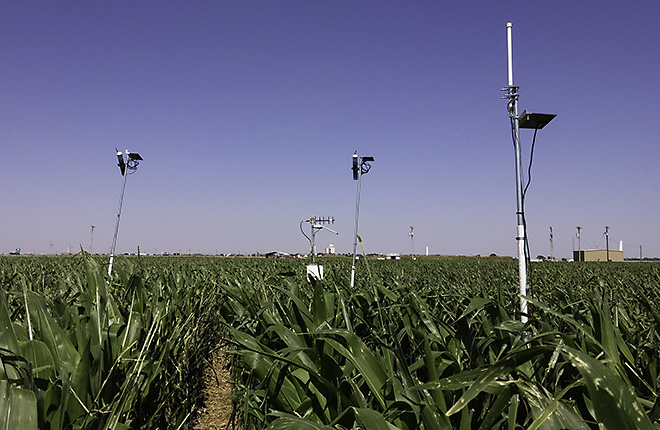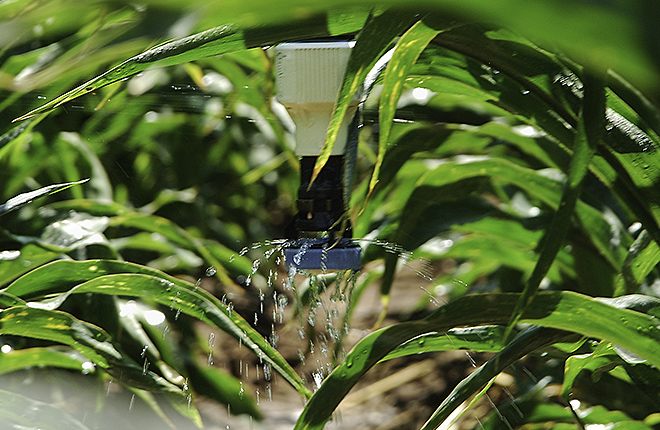Matching Water Drops to the Needs of Crops
High-speed wireless connectivity isn’t just convenient for cell phone and Internet use anymore. It could also become key to automated methods that determine where, when, and how much to irrigate crops for optimal growth and yield.
In Bushland, Texas, Agricultural Research Service (ARS) scientists are testing a wireless sensor-based decision-support system that could help automated center-pivot irrigation systems tailor water application rates to specific areas of a crop field—on the fly and using real-time data.
 Solar-powered soil water station in a corn field helps to prevent over- and under-irrigation of the variable-rate irrigation system. (Nancy Davis, D3888-1) |
Known as Irrigation Scheduling Supervisory Control and Data Acquisition, or ISSCADA, the patented system will allow for “applying the right amount of water at the right time and in the right location in a field,” says Susan O’Shaughnessy, an agricultural engineer in the ARS Soil and Water Management Research Unit in Bushland.
Center-pivot irrigation systems are used on 48 percent of U.S. irrigated cropland. The systems require minimal labor and are reliable, easy to operate, and conducive to remote operation and control, she adds. They can also be modified with the latest variable-rate irrigation (VRI) technology, offering a way to improve crop yields, conserve water, and reduce the cost of pumping it.
Typically, center-pivot irrigation systems and other types of moving sprinkler systems apply uniform rates of water as they move around or across the crop field, says ARS agricultural engineer Paul Colaizzi. But considerable variability can exist not only in the field’s terrain and soil composition, but also in the individual plants’ water needs.
In regions where irrigation water is limited, farmers may seek to strike a balance by either spreading water over a large crop area, so the plants get just enough, or by concentrating it in a smaller crop area, so those plants are fully irrigated.
Applying too much water can encourage leaching of nutrients below the root zone, putting them beyond the plants’ reach and closer to underground stores of water. Above ground, surplus water creates conditions for weeds and pests to thrive. Overwatered plants are prone to lodging (falling over) and are more vulnerable to rot and other diseases. But given too little water, parched plants may succumb to heat stress and fall short of their expected yields, depriving farmers of a profitable harvest.
 Variable-rate irrigation sprinkler at Bushland, Texas, equipped with on-board canopy temperature sensors designed by ARS and commercialized by Dynamax, Inc. (Nancy Davis, D3886-1)
|
“Variable-rate irrigation can make it easier to spread water, without undue risk of under-watering, or to concentrate water, with less risk of over-watering,” says O’Shaughnessy.
Although VRI technology is commercially available, there are still costs, learning curves, and other issues associated with adopting it, the researchers note.
“These barriers include the need for high-speed rural internet and cellular service, advanced soil-plant-atmosphere models, appropriate decision-support systems, sufficiently powerful hand-held computers, and wireless sensors that can survive harsh field conditions,” says O’Shaughnessy. “These have been perhaps the most intractable technical barriers so far.” (See “Two Approaches for Optimizing Water Productivity,” AgResearch, April 2013.)
The Bushland team’s ISSCADA system is the culmination of a multifaceted effort to overcome those hurdles. The team’s efforts include not only the development of new, wireless soil-water sensors and plant-canopy thermometers, but also mathematical algorithms. Using data acquired from the sensors, the algorithms create daily crop-stress indices and threshold levels that can be integrated with color-coded, geographic information system (GIS) maps. The GIS maps show where, when, and how much farmers should irrigate—or if they should withhold irrigation.
In field trials with corn, cotton, sorghum, and soybeans, ISSCADA-controlled center-pivot irrigators performed as well as irrigators that had been manually programed by the team. Tests of ISSCADA under different conditions are also under way at ARS sites in Portageville, Missouri; Stoneville, Mississippi; and Florence, South Carolina.
The researchers are collaborating with three companies (Valmont, Dynamax, and Acclima) to refine the irrigation-scheduling system they’ve developed and integrate it with existing VRI systems. Under a cooperative research and development agreement, “we are developing a client/server software package that integrates the sensor network systems with VRI hardware so that a farmer can easily use the system for precision irrigation,” says O’Shaughnessy. A grant from the USDA National Institute of Food and Agriculture also funds this work.
Colaizzi expects this capability to become especially important, given the increasing off-farm competition for water for residential, recreational, municipal, and other uses.
At the end of the day, it’s all about having the right tools on hand to make the best decisions possible, the researchers note.
“As long as we’re growing crops and have to eat, water will be one of the main variables to be managed—whether it’s ‘more crop per drop or less drop per crop,’” says Colaizzi.—By Jan Suszkiw, ARS Office of Communications.
Key Facts
- Center-pivot (CP) irrigation systems are used on 48 percent of U.S. irrigated cropland.
- CP irrigation systems are popular, but they can over- or under-water crops.
- ARS wireless sensors aboard CPs gather current data on crop conditions.
- ARS decision-support system uses sensor data to guide precision irrigation.
Full Story









